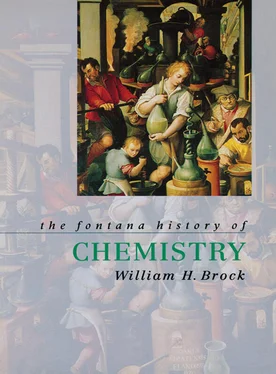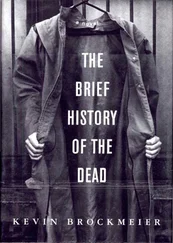In these three assumptions Dalton moved away completely from the tradition of eighteenth-century matter theory, which had emphasized the identity of matter and of all material substances. In so doing. Dalton intimately bound his kind of atomism to the question of how elements were to be defined. In a final assumption, he proposed to do something that neither Lavoisier nor Higgins had thought of doing, namely to rid metaphysical atomism of its intangibleness by fixing a determinable property to it, that of relative atomic weight. To perform this transductive trick, Dalton had to make a number of simple assumptions about how atoms would combine to form compound atoms, the process he termed chemical synthesis. In the simplest possible case, ‘when only one combination of two bodies can be obtained, it must be presumed to be a binary one, unless some cause appear to the contrary’. In other words, although substances A and B might combine to form A 2B 2, it is simpler to assume that they will usually form just AB. Similarly, if ‘two combinations are observed, they must be presumed to be a binary and a ternary ’:
A + 2B = AB 2or 2A + B = A 2B
Dalton made similar rules for cases of three and four compounds of the same elements, and pointed out that the rules of synthesis also applied to the combination of compounds:
CD + DE = CD 2E etc.
These assumptions of simplicity of composition, which, as we shall see, had a theoretical justification, have long since been replaced by different criteria. Although they led to many erroneous results, the assumptions proved fruitful since they allowed relative atomic weights to be calculated. Two examples, both given by Dalton, will suffice.
Hydrogen and oxygen were known to form water. Before 1815, when hydrogen peroxide was discovered, this was the only known compound of these two gases. Dalton quite properly assumed, therefore, that they formed a binary compound; in present-day symbols:
H + O = HO
From Humboldt and Gay-Lussac’s analyses of water, it was known that 87.4 parts by weight of oxygen combined with 12.6 parts of hydrogen to form water. This ratio, H : O :: 12.6 : 87.4, must also be the ratio of the individual weights of hydrogen and oxygen atoms that make up the binary atom of water. Since hydrogen is the lightest substance known, it made sense to’ adopt it as a standard and to compare all heavier chemical objects with it. If the hydrogen atom is defined as having a weight of 1, the relative atomic weight of an atom of oxygen will be roughly 7. (Dalton always rounded calculations up or down to the nearest whole number.) Similarly, Dalton assumed ammonia to be a binary compound of azote (nitrogen) and hydrogen. From Berthollet’s analysis he calculated the relative atomic weight of nitrogen to be 5 or, after further experiments in 1810, 6.
TABLE 4.1 Some of Dalton’s relative weights.

Dalton was well aware of the arbitrary nature of his rules of simplicity. In the second part of the New System in 1810 he allowed the possibility that water could be a ternary compound, in which case oxygen would be 14 times heavier than hydrogen; or, if two atoms of oxygen were combined with one of hydrogen, oxygen’s atomic weight would be 3.5. This uncertainty was to plague chemists for another fifty years.
From the beginning, Dalton symbolized his atoms 2 :
… by a small circle, with some distinctive mark; and the combinations consist in the juxta-position of two or more of these.
The synthesis of water and ammonia were represented as:

Such symbols referred to the atom and were therefore conceptually very different from alchemical symbols or those of Hassenfratz and Adet, which only had a hazy or qualitative meaning. Earlier symbols had been a shorthand; Dalton’s circles conveyed a theoretical meaning as well as being a convenient abbreviation.
Dalton was never to become reconciled to the symbols introduced by Berzelius, even though he himself used alphabetical abbreviations within circles for elements such as iron, sulphur, copper and lead. In 1837, soon after the British Association for the Advancement of Science had persuaded British chemists to adopt Berzelius’ symbols, Dalton wrote a testimonial for Thomas Graham’s application for the Chair of Chemistry at University College London.
Berzelius’s symbols are horrifying: a young student in chemistry might as soon learn Hebrew as make himself acquainted with them. They appear like a chaos of atoms. Why not put them together in some sort of order?…[They] equally perplex the adepts of science, discourage the learner, as well as to cloud the beauty and simplicity of the Atomic Theory.
Clearly Dalton felt strongly about his innovation and was prepared to criticize a professorial candidate with one hand while supporting him with another. Indeed, Dalton suffered the first of his two strokes in April 1837 after angrily discussing symbols with a visitor.
Dalton’s symbols did not survive, mainly one suspects because they were an additional printing expense, but both they, as well as Berzelius’ simplification, encouraged people to acquire a faith in the reality of chemical atoms and enabled chemists to visualize relatively complex chemical reactions. As in mathematics, chemistry could advance only to a certain degree without an adequate symbolism for its deeper study. Between them, Lavoisier and Dalton completed a revolution in the language of chemistry.
Dalton’s hieroglyphs also reveal that he had a three-dimensional geometrical model of combination in mind. When three or more particles combined, he conceived that like particles stationed themselves as far apart as possible. This conception offers not only an important clue concerning the origins of Dalton’s atomic theory, but an explanation of his opposition to the notion derived from the volumetric combination of gases that equal volumes contained equal numbers of particles.
THE ORIGINS OF DALTON’S THEORY
How did Dalton come to think of weighing atoms? There have been many different attempts by chemists and historians to explain this. Dalton supplied three, mutually inconsistent, accounts of his voyage of discovery. Reconstruction has been made difficult by the fact that most of Dalton’s surviving papers were destroyed during the Second World War, and, but for the fact that Henry Roscoe and Arthur Harden quoted from them in a historical study published in 1896, historians would have been hard-pressed for evidence. Although the debate over influences remains unresolved, all historians agree that Dalton must have come to his ‘new views’ through the study of the physical properties of gases, which in turn depended upon his youthful interest in meteorology. For, once air had been shown to be heterogeneous, and not a homogeneous element, the question arose whether oxygen, nitrogen, carbon dioxide and water vapour were chemically combined in air (perhaps a compound actually dissolved in the water vapour?) or merely mixed together. The fact that atmospheric air appeared to be homogeneous and that its gaseous components were not stratified according to their specific gravities (itself an indication that chemists like Priestley were prepared to think in terms of the specific weights of gas particles long before Dalton) made most late-eighteenth-century chemists believe that atmospheric gases were chemically combined.
Читать дальше














